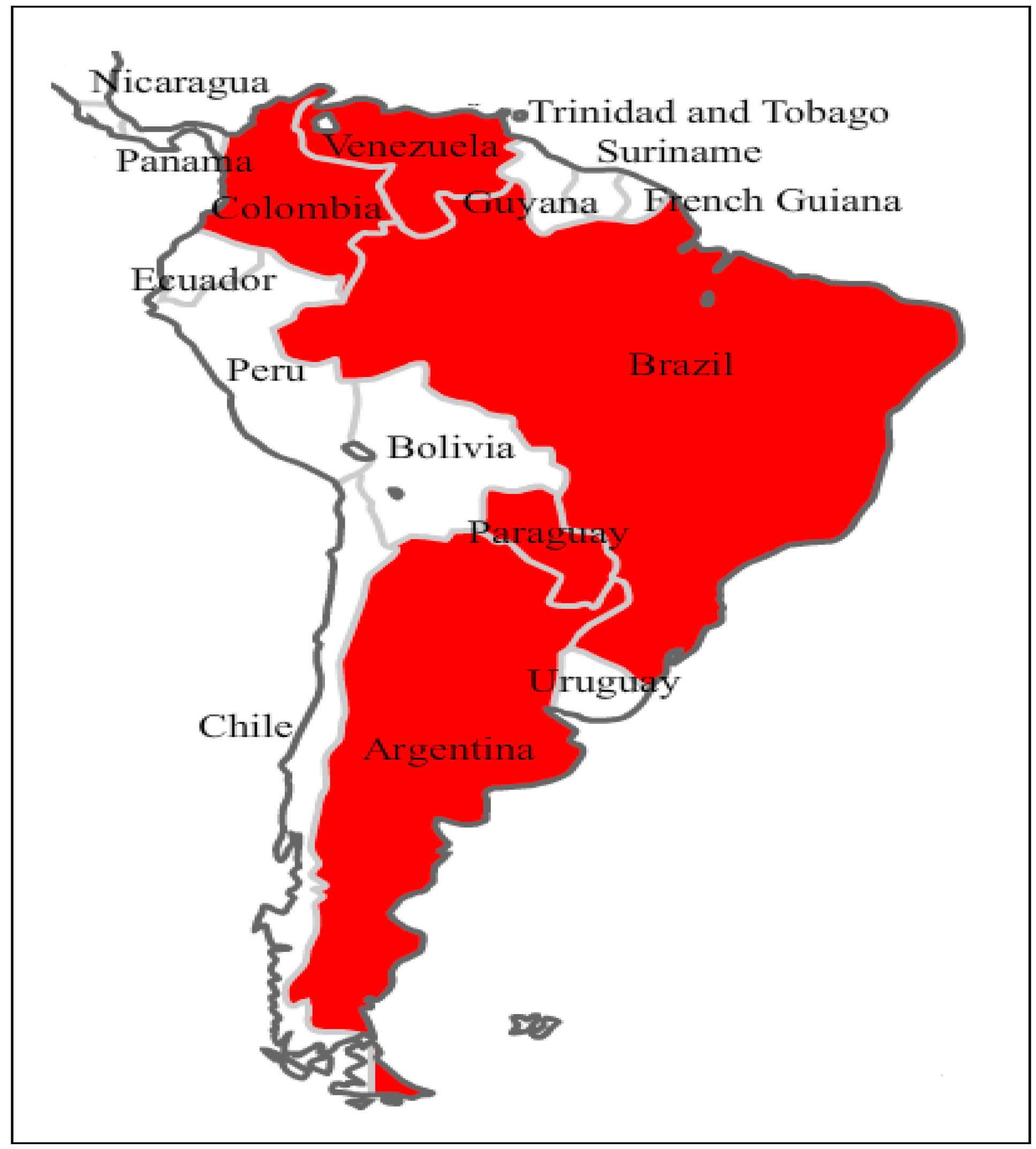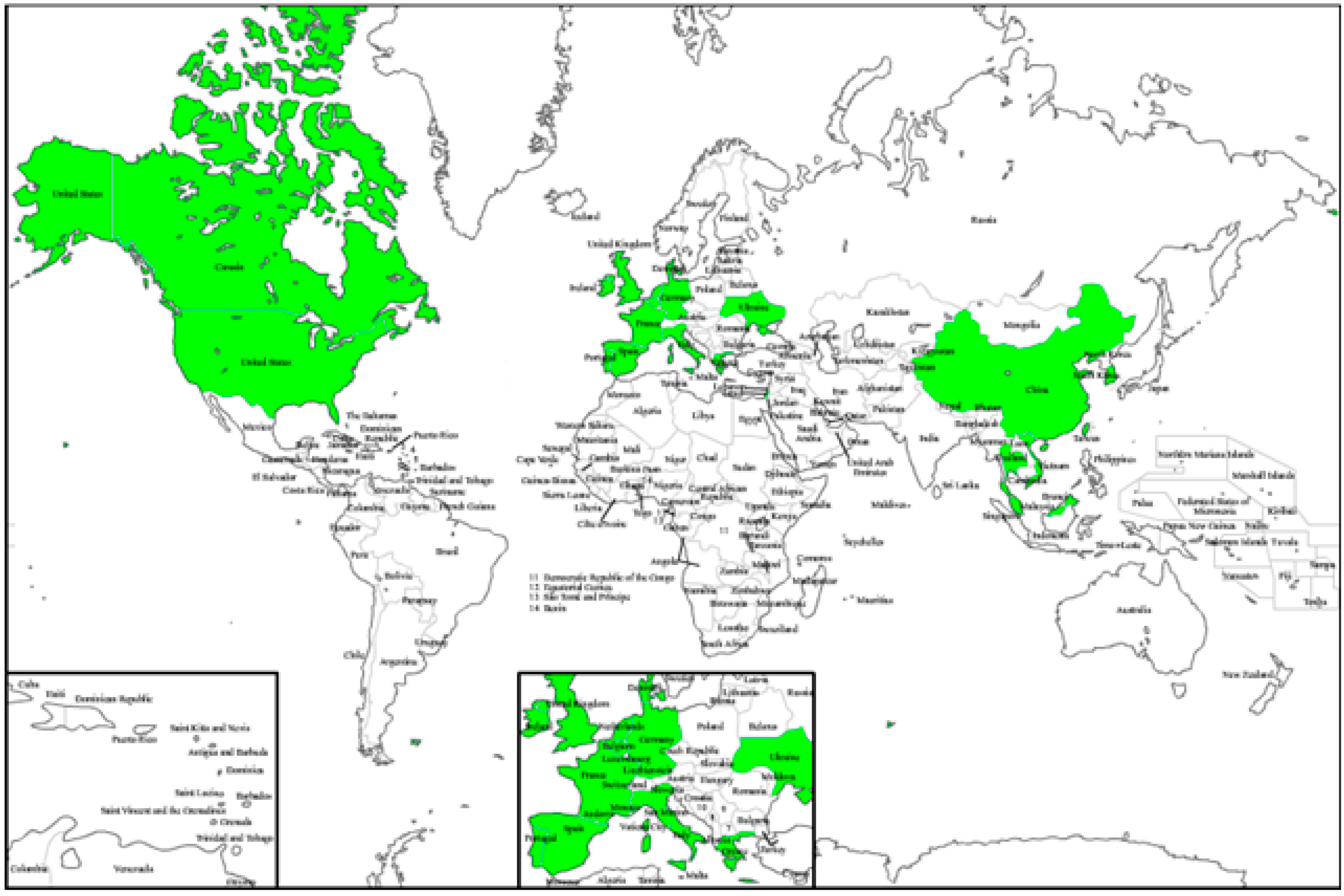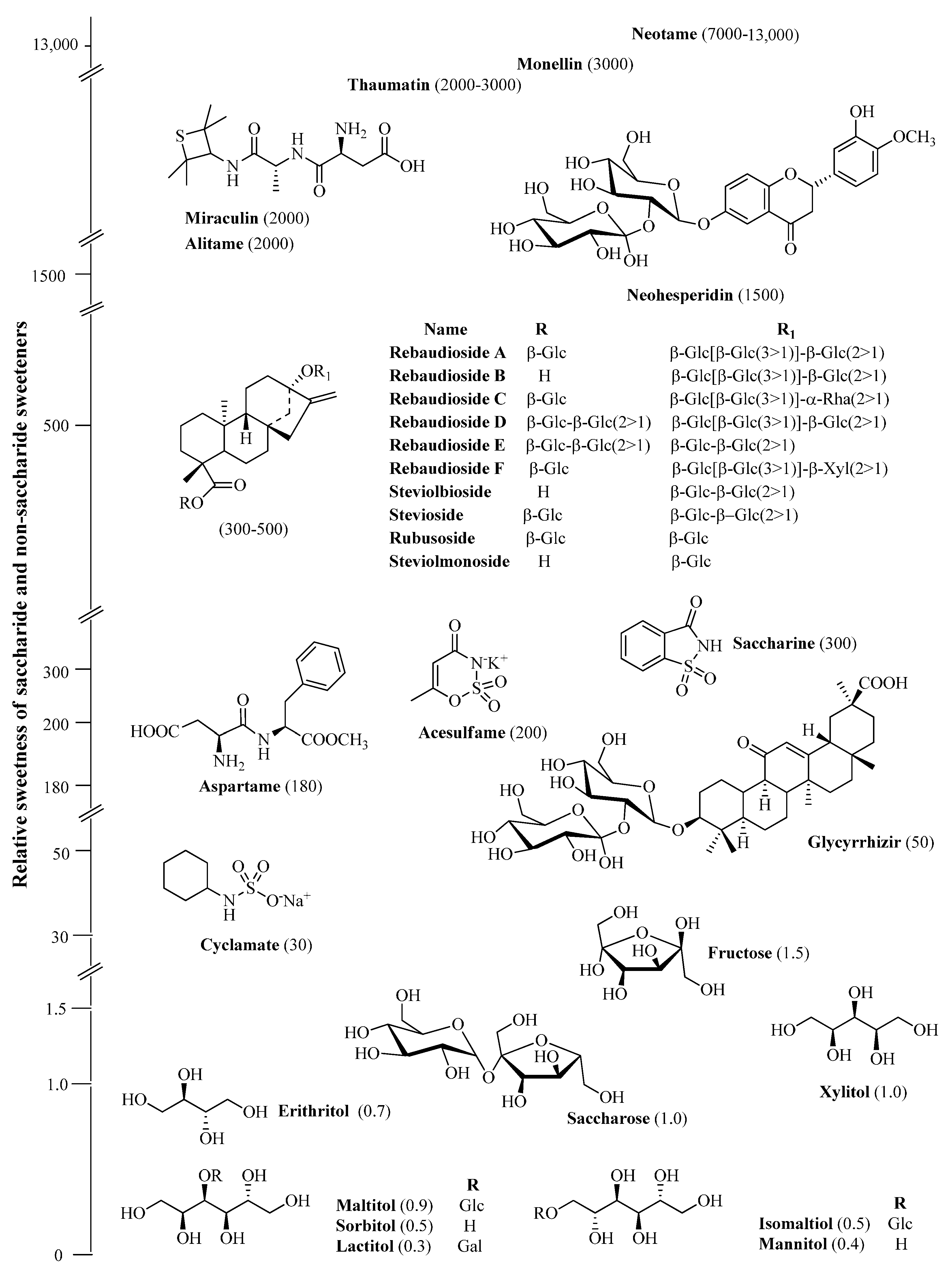Is Stevia rebaudiana Bertoni a Non Cariogenic Sweetener? A Review
Abstract
:1. Introduction
2. Dental Caries Pathogenesis and Its Relation with Alimentary Factors
2.1. Development of Natural Sweeteners in Food Factory Research
2.2. The Genus Stevia: Botanical and Ethnobotanical Remarks, with an Emphasis on S. rebaudiana Bertoni


2.3. S. rebaudiana Chemical Constituents and Extraction Procedures
| Extraction Method | Problems/Advantages/Disadvantages | Ref. |
|---|---|---|
| Water extraction process | Optimization in terms of pH, temperature, pressure, duration. | [31] |
| Water leaching | Time and labor consumption. | [32] |
| Ethanol leaching | More rapid than water leaching, keeping the same extraction recovery. | [32] |
| Supercritical fluid extraction (SFE) | Low solvation power for polar stevioside, need to use a co-solvent. Optimization in terms of pressure and temperature. | [32] |
| Pressurized fluid extraction (PFE) | Multiple rate, lower solvent consumption, enhanced mass transfer and increased solvation power. Limited to thermally stable analytes. | [32] |
| Pressurized hot water extraction (PHWE)/subcritical water extraction | Extraction of nonpolar compounds with water, environmentally-friendly and economically-beneficial alternative to harmful organic solvents. | [32] |
| Microwave assisted extraction | Optimization in terms of solvent and solvent volume. Extraction of compounds of commercial importance in less time, with lesser solvent and causing comparatively lesser harm to the environment. | [33] |
| Soxhlet extraction | Optimization in terms of time, solvent, and solvent volume. | [33] |
| Cold maceration | Optimization in terms of time, solvent, and solvent volume. | [33] |

2.4. Medicinal and Alimentary Uses of S. rebaudiana Glycosides
| Species | Medicinal Uses |
|---|---|
| S. balansae Hieron. | Intestinal affections |
| S. cardiatica Perkins | Cardiac affections |
| S. connata Lag. | Gastric affections |
| S. elatior H. B. K | Vulnerary, Dermatologic affections |
| S. eupatoria (Spreng.) Willd. | Renal affections |
| S. glandulosa Hook. & Arn. | Antipyretic, Cold |
| S. lucida Lag. | Anti-inflammatory, Anti-dolorific, Flue, Vulnerary |
| S. macbridei B. L. Rob. | Gynecologic affections |
| S. nepetifolia H. B. K. | Gynecologic affections |
| S. pilosa Lag. | Antipyretic, Intestinal affections, Renal affections |
| S. plummense A. Gray | Vulnerary |
| S. puberula Hook. | Gastric affections |
| S. rebaudiana (Bert.) Bertoni | Gynecologic affections, Anti-diabetic |
| S. rhombifolia Kunth | Gastric affections |
| S. salicifolia Cav. | Anti-rheumatic, Intestinal affections, Cold |
| S. serrata Cav. | Vulnerary, Anti-cough |
| S. subpubescens Lag. | Anti-dolorific, Gynecologic affections, Gastric affections |
| S. trifida Lag. | Gastrointestinal affections |
| Medicinal Properties | Ref. |
|---|---|
| Anti-hyperglycemic/Anti-diabetic | [40] |
| Anti-Inflammatory | [47] |
| Antimicrobial | [41] |
| Antioxidant | [40] |
| Antitumor | [42] |
| Antiviral | [45] |
| Immunomodulatory | [46] |
| Gastroprotective activity | [43] |
| Renal protective | [44] |
2.5. Caries Prevention Activity of S. rebaudiana Extracts and Steviol Glycosides
| Source | Type of Study | Results | Ref. |
|---|---|---|---|
| S. rebaudiana aqueous extract | In vivo | Reduction of plaque index by 70.47%. | [56] |
| S. rebaudiana aqueous extracts | In vitro | Reduction of extracellular polysaccharide formation. | [57] |
| S. rebaudiana methanol and ethanol extracts | In vitro | Inhibition of growth of Lactobacilli. | [58] |
| S. rebaudiana aqueous extracts | In vivo | Reduction of plaque index. | [59] |
| S. rebaudiana aqueous extracts | In vitro and in vivo | S. rebaudiana extracts are non-acidogenic. | [16] |
| Solution containing 0.5% Stevioside and Rebaudioside A | In vivo | Dental plaque reduction was not evident using stevioside mouth rinses. | [61] |
| Stevioside extracts | In vitro | Stevioside and rebaudioside A are not cariogenic. | [60] |
3. Future Research
Author Contributions
Conflicts of Interest
References
- Bourgeois, D.M.; Llodra, J.C. Global burden of dental condition among children in nine countries participating in an international oral health promotion programme, 2012–2013. Int. Dent. J. 2014, 64, 27–34. [Google Scholar] [CrossRef] [PubMed]
- Dye, B.A.; Tan, S.; Smith, V.; Lewis, B.G.; Barker, L.K.; Thornton-Evans, G.; Eke, P.I.; Beltrán-Aguilar, E.D.; Horowitz, A.M.; Li, C.H. Trends in oral health status: United States, 1988–1994 and 1999–2004. Vital Health Stat. 2007, 248, 1–92. [Google Scholar]
- Cariño, K.M.; Shinada, K.; Kawaguchi, Y. Early childhood caries in northern Philippines. Commun. Dent. Oral Epidemiol. 2003, 31, 81–89. [Google Scholar] [CrossRef]
- Ferro, R.; Besostri, A.; Meneghetti, B.; Olivieri, A.; Benacchio, L.; Tabaccanti, S.; Mazzoleni, S.; Favero, G.; Stellini, E. Oral health inequalities in preschool children in North-Eastern Italy as reflected by caries prevalence. Eur. J. Paediatr. Dent. 2007, 8, 13–18. [Google Scholar] [PubMed]
- Ferrazzano, G.F.; Scaravilli, M.S.; Ingenito, A. Dental and periodontal health status in Campanian children and relation between caries experience and socio-economic behavioural factors. Eur. J. Paediatr. Dent. 2006, 7, 174–178. [Google Scholar] [PubMed]
- Ferrazzano, G.F.; Sangianantoni, G.; Cantile, T.; Ingenito, A. Relationship between social and behavioural factors and caries experience in schoolchildren in Italy. Oral Health Prev. Dent. 2015. [Google Scholar] [CrossRef]
- Folayan, M.O.; Kolawole, K.A.; Oziegbe, E.O.; Oyedele, T.; Oshomoji, O.V.; Chukwumah, N.M.; Onyejaka, N. Prevalence, and early childhood caries risk indicators in preschool children in suburban Nigeria. BMC Oral Health 2015, 15, 72. [Google Scholar] [CrossRef] [PubMed]
- Jeon, J.G.; Rosalen, P.L.; Falsetta, M.L.; Koo, H. Natural products in caries research: Current (limited) knowledge, challenges and future perspective. Caries Res. 2011, 45, 243–263. [Google Scholar] [CrossRef] [PubMed]
- Ferrazzano, G.F.; Amato, I.; Cantile, T.; Sangianantoni, G.; Ingenito, A. In vivo remineralising effect of GC tooth mousse on early dental enamel lesions: SEM analysis. Int. Dent. J. 2011, 61, 210–216. [Google Scholar] [PubMed]
- Ferrazzano, G.F.; Roberto, L.; Amato, I.; Cantile, T.; Sangianantoni, G.; Ingenito, A. Antimicrobialproperties of green tea extract against cariogenic microflora: An in vivo study. J. Med. Food 2011, 14, 907–911. [Google Scholar] [CrossRef] [PubMed]
- Ferrazzano, G.F.; Cantile, T.; Quarto, M.; Ingenito, A.; Chianese, L.; Addeo, F. Protective effect of yogurt extract on dental enamel demineralization in vitro. Aust. Dent. J. 2008, 53, 314–319. [Google Scholar] [CrossRef] [PubMed]
- Mirpour, M.; Siahmazgi, Z.G.; Kiasaraie, M.S. Antibacterial activity of clove, gall nut methanolic and ethanolic extracts on Streptococcus mutans PTCC 1683 and Streptococcus salivarius. J. Oral Biol. Craniofac. Res. 2015, 5, 7–10. [Google Scholar] [CrossRef] [PubMed]
- Sheiham, A.; James, W.P.T. A reappraisal of the quantitative relationship between sugar intake and dental caries: The need for new criteria for developing goals for sugar intake. BMC Public Health. 2014, 14, 863. [Google Scholar] [CrossRef] [PubMed]
- Kawashita, Y.; Kitamura, M.; Saito, T. Early childhood caries. Int. J. Dent. 2011, 725320. [Google Scholar] [CrossRef] [PubMed]
- Giacaman, R.A.; Contzen, M.P.; Yuri, J.A.; Muñoz-Sandoval, C. Anticaries effect of an antioxidant-rich apple concentrate on enamel in an experimental biofilm-demineralization model. J. Appl. Microbiol. 2014, 117, 846–853. [Google Scholar] [CrossRef] [PubMed]
- Brambilla, E.; Cagetti, M.G.; Ionescu, A.; Campus, G.; Lingström, P. An in vitro and in vivo comparison of the effect of Stevia rebaudiana extracts on different caries-related variables: A randomized controlled trial pilot study. Caries Res. 2014, 48, 19–23. [Google Scholar] [CrossRef] [PubMed]
- Gupta, P.; Gupta, N.; Pawar, A.P.; Birajdar, S.S.; Natt, A.S.; Singh, H.P. Role of sugar and sugar substitutes in dental caries: A review. ISRN Dent. 2013, 29. [Google Scholar] [CrossRef] [PubMed]
- Raben, A.; Vasilaras, T.H.; Møller, A.C.; Astrup, A. Sucrose compared with artificial sweeteners: Different effects on ad libitum food intake and body eight after 10 wk of supplementation in overweight subjects. Am. J. Clin. Nutr. 2002, 76, 721–729. [Google Scholar] [PubMed]
- Laville, M.; Nazare, J.A. Diabetes, insulin resistance and sugars. Obes. Rev. 2009, 10, 24–33. [Google Scholar] [CrossRef] [PubMed]
- Gentry, A.H. A Field Guide of the Families and Genera of Woody Plants of Northwest South America (Colombia, Ecuador, Peru) with Supplementary Notes on Herbaceus Taxa; The University of Chicago Press: Chicago, IL, USA, 1996; p. 895. [Google Scholar]
- Robinson, R.L. Contributions from the Gray Herbarium of Harvard University XC; The Gray Herbarium of Harvard University: Cambridge, MA, USA, 1930; pp. 78–91. [Google Scholar]
- Watanabe, K.; Yahara, T.; Denda, T.; Kosuge, K. Chromosomal evolution in the genus Brachyscome (Asteraceae, Astereae): Statistical tests regarding correlation between changes in karyotype and habit using phylogenetic information. J. Plant Res. 1999, 112, 145–146. [Google Scholar] [CrossRef]
- Soejarto, D.D.; Compadre, C.M.; Medon, P.J.; Kamath, S.K.; Kinghorn, A.D. Potential sweetening agents of plant origin. II. Field search for sweet-tasting Stevia species. Econ. Bot. 1983, 37, 71–79. [Google Scholar] [CrossRef]
- Lemus-Mondaca, R.; Vega-Gálvez, A.; Zura-Bravo, L.; Ah-Hen, K. Stevia rebaudiana Bertoni, source of a high-potency natural sweetener: A comprehensive review on the biochemical, nutritional and functional aspects. Food Chem. 2012, 132, 1121–1132. [Google Scholar] [CrossRef]
- Kinghorn, A.D. Stevia: The Genus Stevia; CRC Press: Boca Raton, FL, USA, 2003; p. 224. [Google Scholar]
- Chatsudthipong, V.; Muanprasat, C. Stevioside and related compounds: Therapeutic benefits beyond sweetness. Pharmacol. Ther. 2009, 121, 41–54. [Google Scholar] [CrossRef] [PubMed]
- Ramesh, K.; Singh, V.; Megeji, N.W. Cultivation of Stevia [Stevia rebaudiana (Bert.) Bertoni]: A comprehensive review. Adv. Agron. 2006, 89, 137–177. [Google Scholar]
- Singh, S.D.; Rao, G.P. Stevia: The herbal sugar of 21st Century. Sugar Tech 2005, 7, 17–24. [Google Scholar] [CrossRef]
- Soejarto, D.D. Botany of Stevia and Stevia rebaudiana. In Stevia. The genus Stevia, 1st ed.; Kinghorn, A.D., Ed.; Taylor & Francis Inc.: New York, NY, USA, 2002; pp. 18–39. [Google Scholar]
- Aminha, S.; Soumya, A.N.; Raju, V.G.; Goud, B.M.; Irfath, M.; Quadri, S.A.P. Isolation and extraction of artificial sweetner (Stevia). World J. Pharm. Res. 2014, 3, 481–486. [Google Scholar]
- Rao, A.B.; Reddy, G.R.; Ernala, P.; Sridhar, S.; Ravikumar, Y.V.L. An improvised process of isolation, purification of steviosides from Stevia rebaudiana Bertoni leaves and its biological activity. Int. J. Food Sci. Technol. 2012, 47, 2554–2560. [Google Scholar] [CrossRef]
- Pol, J.; Varadova, O.E.; Karasek, P.; Roth, M.; Benesova, K.; Kotlarikova, P.; Caslavsky, J. Comparison of two different solvents employed for pressurized fluid extraction of stevioside from Stevia rebaudiana: Methanol versus water. Anal. Bioanal. Chem. 2007, 388, 1847–1857. [Google Scholar] [CrossRef] [PubMed]
- Javad, S.; Naz, S.; Ilyas, S.; Tariq, A.; Aslam, F. Optimization of the microwave assisted extraction and its comparison with different conventional extraction methods for isolation of stevioside from Stevia rebaudiana. Asian J. Chem. 2014, 26, 8043–8048. [Google Scholar]
- Kolb, N.; Herrera, J.L.; Ferreyra, D.J.; Uliana, R.F. Analysis of sweet diterpene glycosides from Stevia rebaudiana: Improved HPLC method. J. Agr. Food Chem. 2001, 49, 4538–4541. [Google Scholar] [CrossRef]
- Morlock, G.E.; Meyer, S.; Zimmermann, B.F.; Roussel, J.M. High-performance thin-layer chromatography analysis of steviol glycosides in Stevia formulations and sugar-free food products, and benchmarking with (ultra) high-performance liquid chromatography. J. Chromatogr. 2014, 1350, 102–111. [Google Scholar] [CrossRef] [PubMed]
- Chaturvedula, V.S.P.; Prakash, I. A new diterpene glycoside from Stevia rebaudiana. Molecules 2011, 16, 2937–2943. [Google Scholar] [CrossRef] [PubMed]
- Ohta, M.; Sasa, S.; Inoue, A.; Tamai, T.; Fujita, I.; Morita, K.; Matsuura, F. Characterization of novel steviol glycosides from leaves of Stevia rebaudiana. J. Appl. Glycosci. 2010, 57, 199–209. [Google Scholar] [CrossRef]
- Matsukubo, T.; Takazoe, I. Sucrose substitutes and their role in caries prevention. Int. Dent. J. 2006, 56, 119–130. [Google Scholar] [CrossRef] [PubMed]
- Giongo, F.C.; Mua, B.; Parolo, C.C.; Carlén, A.; Maltz, M. Effects of lactose-containing stevioside sweeteners on dental biofilm acidogenicity. Braz. Oral Res. 2014, 28, S1806–S8324. [Google Scholar] [CrossRef] [PubMed]
- Kelmer, B.A.; Alvarez, M.; Brancht, A. Effects of Stevia rebaudiana natural products on rat liver mithocondria. Biochem. Pharmacol. 1985, 34, 873–882. [Google Scholar]
- Jayaraman, S.; Manoharan, M.S.; Illanchezian, S. In-vitro Antimicrobial and antitumor activities of Stevia rebaudiana (Asteraceae) leaf extracts. Trop. J. Pharm. Res. 2008, 7, 1143–1149. [Google Scholar] [CrossRef]
- Mizushina, Y.; Akihisa, T.; Ukiya, M.; Hamasaki, Y.; Nakai, C.M.; Kuriyama, I.; Tkeuchi, T.; Sugawara, F.; Yoshida, H. Structural analysis of isosteviol and related compounds as DNA polymerase and DNA topoisomerase inhibitors. Life Sci. 2005, 77, 2127–2140. [Google Scholar] [CrossRef] [PubMed]
- Shiozaki, K.; Fujii, A.; Nakano, T.; Yamaguchi, T.; Dato, M. Inhibitory effects of hot water extract of the Stevia stem on the contractile response of the smooth muscle of the guinea pig ileum. Biosci. Biotechnol. Biochem. 2006, 70, 489–494. [Google Scholar] [CrossRef] [PubMed]
- Melis, M.S. Chronic administration of aqueous extract of Stevia rebaudiana in rats: Renal effects. J. Ethnopharmacol. 1995, 47, 129–134. [Google Scholar] [CrossRef]
- Takahashi, K.; Matsuda, N.; Ohashi, K.; Taniguchi, K.; Nakagomi, O.; Abe, Y.; Mori, S.; Okutani, N.K.; Shigeta, S. Analysis of anti-rotavirus activity of extract from Stevia rebaudiana. Antivir. Res. 2001, 49, 15–24. [Google Scholar] [CrossRef]
- Sehar, I.; Kaul, A.; Bani, S.; Pal, H.C.; Saxena, A.K. Immune up regulatory response of a non-caloric natural sweetener, stevioside. Chem. Biol. Interact. 2008, 173, 115–121. [Google Scholar] [CrossRef] [PubMed]
- Boonkaewwan, C.; Toskulkao, C.; Vongsakul, M.J. Antinflammatory and immunomodulatory activities of stevioside and its metabolite steviol on THP-1 cells. J. Agric. Food Chem. 2006, 54, 785–789. [Google Scholar] [CrossRef] [PubMed]
- Soejarto, D.; Compadre, C.M.; Kinghorn, A.D. Ethnobotanical Notes on Stevia; Botanical Museum Leaflets Harvard University: Cambridge, MA, USA, 1983; pp. 1–25. [Google Scholar]
- Soejarto, D.D. Ethnobotany of Stevia and Stevia rebaudiana. In Stevia. The Genus Stevia; Kinghorn, A.D., Ed.; CRC Press: London, UK; New York, NY, USA, 2001; pp. 40–67. [Google Scholar]
- Fengyang, L.; Yunhe, F.; Bo, L.; Zhicheng, L.; Depeng, L.; Dejie, L.; Wen, Z.; Yongguo, C.; Naisheng, Z.; Xichen, Z.; Zhengtao, Y. Stevioside suppressed inflammatory cytokine secretion by downregulation of NF-κB and MAPK signalling pathways in LPS-stimulated RAW264.7 cells. Inflammation 2012, 35, 1669–1675. [Google Scholar] [CrossRef] [PubMed]
- Boonkaewwan, C.; Ao, M.; Toskulkao, C.; Rao, M.C. Specific Immunomodulatory and Secretory Activities of Stevioside and Steviol in Intestinal Cells. J. Agric. Food Chem. 2008, 56, 3777–3784. [Google Scholar] [CrossRef] [PubMed]
- Jeppesen, P.B.; Gregersen, S.; Rolfsen, S.E.; Jepsen, M.; Colombo, M.; Agger, A.; Xiao, J.; Kruhoffer, M.; Orntoff, T.; Hermansen, K. Antihyperglycemic and blood pressure-reducing effects of stevioside in the diabetic Goto-Kakizaki rat. Metabolism 2003, 52, 372–378. [Google Scholar] [CrossRef] [PubMed]
- Tandel, K.R. Sugar substitutes: Health controversy over perceived benefits. J. Pharmacol. Pharmacother. 2011, 2, 236–243. [Google Scholar] [CrossRef] [PubMed]
- Beck, A.; Cabaret, J.; Halberg, N.; Ivanova-Peneva, S.; Jespersen, L.M. Joint FAO/WHO Expert Committee on Food Additives 2008. Commission Regulation (EU) No 1131/2011 of 11 November 2011 amending Annex II to Regulation (EC) No 1333/2008 of the European Parliament and of the Council with regard to steviol glycosides. Off. J. Eur. Union 2011, 54, 207. [Google Scholar]
- Mohire, N.C.; Yadav, A.V. Chitosan-based polyherbal toothpaste: As novel oral hygiene product. Indian J. Dent. Res. 2010, 21, 380–384. [Google Scholar] [CrossRef] [PubMed]
- Giacaman, R.A.; Campos, P.; Muñoz-Sandoval, C.; Castro, R.J. Cariogenic potential of commercial sweeteners in an experimental biofilm caries model on enamel. Arch. Oral. Biol. 2013, 58, 1116–1122. [Google Scholar] [CrossRef] [PubMed]
- Gamboa, F.; Chaves, M. Antimicrobial potential of extracts from Stevia rebaudiana leaves against bacteria of importance in dental caries. Acta Odontol. Latinoam. 2012, 25, 171–175. [Google Scholar] [PubMed]
- De Slavutzky, S.M.B. Stevia and sucrose effect on plaque formation. J. Verbr. Lebensm. 2010, 5, 213–216. [Google Scholar] [CrossRef]
- Das, S.; Das, A.K.; Murphy, R.A.; Punwani, I.C.; Nasution, M.P.; Kinghorn, A.D. Evaluation of the cariogenic potential of the intense natural sweeteners stevioside and rebaudioside A. Caries Res. 1992, 26, 363–366. [Google Scholar] [CrossRef] [PubMed]
- Zanela, N.L.; Bijella, M.F.; Rosa, O.P. The influence of mouthrinses with antimicrobial solutions on the inhibition of dental plaque and on the levels of mutans streptococci in children. Pesqui. Odontol. Bras. 2002, 16, 101–106. [Google Scholar] [CrossRef] [PubMed][Green Version]
- Ferrazzano, G.F.; Cantile, T.; Roberto, L.; Ingenito, A.; Catania, M.R.; Roscetto, E.; Palumbo, G.; Zarrelli, A.; Pollio, A. Determination of the in vitro and in vivo antimicrobial activity on salivary Streptococci and Lactobacilli and chemical characterisation of the phenolic content of a Plantago lanceolata infusion. Biomed. Res. Int. 2015, 2015. [Google Scholar] [CrossRef] [PubMed]
- Ferrazzano, G.F.; Roberto, L.; Catania, M.R.; Chiaviello, A.; De Natale, A.; Roscetto, E.; Pinto, G.; Pollio, A.; Ingenito, A.; Palumbo, G. Screening and scoring of antimicrobial and biological activities of italian vulnerary plants against major oral pathogenic bacteria. Evid. Based Complement. Altern. Med. 2013, 2013. [Google Scholar] [CrossRef] [PubMed]
- Palombo, E.A. Traditional medicinal plant extracts and natural products with activity against oral bacteria: Potential application in the prevention and treatment of oral diseases. Evid. Based Complement. Altern. Med. 2011, 2011. [Google Scholar] [CrossRef] [PubMed]
- Ferrazzano, G.F.; Amato, I.; Ingenito, A.; de Natale, A.; Pollio, A. Anti-cariogenic effects of polyphenols from plant stimulant beverages (cocoa, coffee, tea). Fitoterapia 2009, 80, 255–262. [Google Scholar] [CrossRef] [PubMed]
- Bonifait, L.; Grenier, D. Cranberry polyphenols: Potential benefits for dental caries and periodontal disease. J. Can. Dent. Assoc. 2010, 76, a130. [Google Scholar] [PubMed]
© 2015 by the authors. Licensee MDPI, Basel, Switzerland. This article is an open access article distributed under the terms and conditions of the Creative Commons by Attribution (CC-BY) license ( http://creativecommons.org/licenses/by/4.0/).
Share and Cite
Ferrazzano, G.F.; Cantile, T.; Alcidi, B.; Coda, M.; Ingenito, A.; Zarrelli, A.; Di Fabio, G.; Pollio, A. Is Stevia rebaudiana Bertoni a Non Cariogenic Sweetener? A Review. Molecules 2016, 21, 38. https://doi.org/10.3390/molecules21010038
Ferrazzano GF, Cantile T, Alcidi B, Coda M, Ingenito A, Zarrelli A, Di Fabio G, Pollio A. Is Stevia rebaudiana Bertoni a Non Cariogenic Sweetener? A Review. Molecules. 2016; 21(1):38. https://doi.org/10.3390/molecules21010038
Chicago/Turabian StyleFerrazzano, Gianmaria Fabrizio, Tiziana Cantile, Brunella Alcidi, Marco Coda, Aniello Ingenito, Armando Zarrelli, Giovanni Di Fabio, and Antonino Pollio. 2016. "Is Stevia rebaudiana Bertoni a Non Cariogenic Sweetener? A Review" Molecules 21, no. 1: 38. https://doi.org/10.3390/molecules21010038
APA StyleFerrazzano, G. F., Cantile, T., Alcidi, B., Coda, M., Ingenito, A., Zarrelli, A., Di Fabio, G., & Pollio, A. (2016). Is Stevia rebaudiana Bertoni a Non Cariogenic Sweetener? A Review. Molecules, 21(1), 38. https://doi.org/10.3390/molecules21010038







